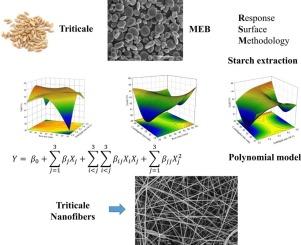应用电纺丝工艺从三尖杉(Triticosecale Wittmack)淀粉中获得纳米纤维的响应面方法和形态评估
IF 5.6
1区 农林科学
Q1 AGRICULTURAL ENGINEERING
引用次数: 0
摘要
本研究采用箱-贝肯实验设计法对三棱麦淀粉提取工艺进行了优化。变量包括固液比(淀粉-水)、(X1 克淀粉/毫升水)、静置时间(X2,分钟)和离心时间(X3,分钟)。获得最大提取率(44.28%)的最佳工艺条件为:淀粉水比 X1=4.03 克/201.77 毫升,X2=29.3 分钟,X3=45 分钟。预测的淀粉产量为 45.32%,而在最佳条件下,实验值为 44.28%。利用扫描电镜研究确定了三棱麦淀粉的特征,并将其与母种小麦和黑麦进行了比较。用电纺丝方法从临界淀粉中获得了纳米纤维。采用 24-1 分因子设计;流量为 0.1 和 0.5 mL/h;电压为 8 和 15 KV;收集针距离为 8 和 10 cm,纳米纤维的直径为响应变量。通过扫描电子显微镜获得纳米纤维的显微照片,以评估其结构、尺寸、直径、串珠或缺陷。纳米纤维的平均直径在 82 纳米到 240 纳米之间。纳米纤维可作为生物活性化合物的支架,应用于食品和制药行业。本文章由计算机程序翻译,如有差异,请以英文原文为准。

Application of the electrospinning process to obtain nanofibers from triticale (Triticosecale Wittmack) starch obtained using the response surface methodology and morphological evaluation
In this study, the triticale starch extraction process was optimized using a Box–Behnken experiment design. The variables were solid-liquid ratio (starch-water), (X1 g of starch/mL of water), rest time (X2, min), and centrifugation time (X3, min). The optimal process conditions to obtain the maximum extraction of triticale starch (44.28 %) were a ratio X1=4.03 g/201.77 mL, X2=29.3 min and X3=45 min. The predicted starch yield was 45.32 % and under optimal conditions, the experimental value was 44.28 %. The characterization of triticale starch was determined and compared with its parent species wheat and rye using SEM studies. Nanofibers were obtained from triticale starch by the electrospinning method. 24–1 fractional factorial design was used; with flow rates of 0.1 and 0.5 mL/h; voltages of 8 and 15 KV; and collector needle distance, 8 and 10 cm, as the factors and the diameter of the nanofibers as the response variable. Micrographs of nanofibers were obtained by SEM to assess their structure, size, diameter, and beading or defects. The average diameter of the obtained nanofibers varied between 82 and 240 nm. Nanofibers can be scaffolds for bioactive compounds in the Food and Pharmaceutical industry.
求助全文
通过发布文献求助,成功后即可免费获取论文全文。
去求助
来源期刊

Industrial Crops and Products
农林科学-农业工程
CiteScore
9.50
自引率
8.50%
发文量
1518
审稿时长
43 days
期刊介绍:
Industrial Crops and Products is an International Journal publishing academic and industrial research on industrial (defined as non-food/non-feed) crops and products. Papers concern both crop-oriented and bio-based materials from crops-oriented research, and should be of interest to an international audience, hypothesis driven, and where comparisons are made statistics performed.
 求助内容:
求助内容: 应助结果提醒方式:
应助结果提醒方式:


